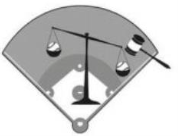The Trademark Trial & Appeal Board affirmed the rejection of three trademark applications, finding that the applied-for marks would cause confusion with a record-setting major league baseball player. Major League Baseball Players Ass’n v. Chisena, Opp. Nos. 91240180; 91242556; 91243244 (TTAB Apr. 12, 2023) (Cataldo, Heasley, Larkin, ATJ.) (precedential).
Michael P. Chisena sought registration of the standard character marks ALL RISE and HERE COMES THE JUDGE, along with the following design mark for use in commerce on “clothing, namely, t-shirts, shirts, shorts, pants, sweatshirts, sweatpants, jackets, jerseys, athletic uniforms, and caps.”

New York Yankees outfielder Aaron Judge and the Major League Baseball Players Association (MLBPA) filed Notices of Opposition challenging Chisena’s registration for likelihood of confusion under Section 2(d) of the Trademark Act, 15 U.S.C. § 1052(d), among other things.
At the outset, the Board addressed the issue of whether Judge and MLBPA were entitled to a statutory cause of action challenging the registration of Chisena’s marks. The Board found standing, concluding that both Judge and MLBPA had “legitimate interest[s] in the outcome of this opposition” because granting Chisena’s registration “would provide a prima facie right to exclusive use of [the] marks on [the] identified apparel, in competition with the apparel marketed by Opposers’ licensees.” The Board reasoned that this stake in the outcome of the opposition created a sufficiently high level of potential harm to Judge and MLBPA to support standing.
Turning to the merits of the Section 2(d) claim, the Board explained that Judge and MLBPA must “prove both priority of use of their pleaded marks and a likelihood of confusion between those marks and those Applicant ha[d] applied to register.”
First, the Board addressed priority of use of ALL RISE and HERE COMES THE JUDGE, as well as judicial designs, such as a gavel, courthouse image or the scales of justice, as trademarks on t-shirts, baseball caps and other athletic apparel. Judge and MLBPA established that Judge had been an MLBPA member since 2016 and that since then, “numerous licensees have obtained approval to produce and market products bearing his personal indicia.”
Chisena responded with multiple arguments in favor of priority but the Board found none to be persuasive. The Board reasoned as follows:
-
“[T]he relevant purchasing public [would] clearly perceive[] ‘JUDGE’ in the context of ‘HERE COMES THE JUDGE’ as a play on words, embracing both its judicial and surname meanings.”
-
“[B]aseball fans and commentators began using ‘ALL RISE’ as a play on Aaron Judge’s last name early in his career,” and whether it is a nickname or not, there is “a protectable property right in any term the public has come to associate with . . . goods or services.”
-
The slogans and symbols function as trademarks because “consumers who encounter [them] on t-shirts and other athletic apparel would recognize, associate, and perceive them as pointing to a single source: Aaron Judge.”
-
“[T]he judicial phrases and symbols . . . serve to perform the function of identifying a secondary source for the apparel on which they appear” because the public would unequivocally associate the phrases and symbols with Judge.
Thus, the Board concluded that Judge and MLBPA had established use of the marks prior to Chisena’s constructive use date.
Next, the Board weighed the DuPont factors to determine “whether there is a likelihood of confusion between the marks.” The first four factors concern the similarity of the marks, similarity of the goods, channels of trade and customers’ care. All four of these factors weighed heavily in favor of Judge and MLBPA. The Board concluded that Chisena’s character marks ALL RISE and HERE COMES THE JUDGE were akin to the “key judicial phrasing used so frequently as a play on Aaron Judge’s name,” and that Chisena’s design mark “confirm[ed] the reference to baseball.”
The Board noted that given the lack of restrictions on Chisena’s channels of trade and “widespread use of judicial phrases and symbols in connection with Mr. Judge[] by a large number of licensees,” the commercial impression of Chisena’s marks “unmistakably” referred to Judge and “convey[ed] the impression that they emanate from one of those licensees” affiliated with Judge and the MLBPA. Moreover, the Board presumed that both parties’ channels of trade would “at least overlap” because “the goods of both parties are at least overlapping.” The Board further reasoned that the nature of Chisena’s proposed goods (i.e., goods “likely to be purchased by consumers on impulse, and without a great deal of care) created a heightened potential for consumer confusion.
Accordingly, the Board sustained the oppositions to Chisena’s proposed marks and refused registration.




 />i
/>i

